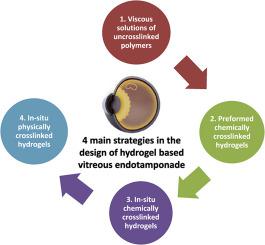Biomaterials ( IF 12.8 ) Pub Date : 2020-11-24 , DOI: 10.1016/j.biomaterials.2020.120547 Qianyu Lin , Jason Y.C. Lim , Kun Xue , Xinyi Su , Xian Jun Loh

|
Vitreous endo-tamponades are commonly used in the treatment of retinal detachments and tears. They function by providing a tamponading force to support the retina after retina surgery. Current clinical vitreous endo-tamponades include expansile gases (such as sulfur hexafluoride (SF6) and perfluoropropane (C3F8)) and also sislicone oil (SiO). They are effective in promoting recovery but are disadvantaged by their lower refractive indices and lower densities as compared to the native vitreous, resulting in immediate blurred vision after surgery and necessitating patients to assume prolonged face-down positioning respectively. While the gas implants diffuse out over time, the SiO implants are non-biodegradable and require surgical removal. Therefore, there is much demand to develop an ideal vitreous endo-tamponade that can combine therapeutic effectiveness with patient comfort. Polymeric hydrogels have since attracted much attention due to their favourable properties such as high water content, high clarity, suitable refractive indices, suitable density, tuneable rheological properties, injectability, and biocompatibility. Many design strategies have been employed to design polymeric hydrogel-based vitreous endo-tamponades and they can be classified into four main strategies. This review seeks to analyse these various strategies and evaluate their effectiveness and also propose the key criteria to design successful polymeric hydrogel vitreous endo-tamponades.
中文翻译:

高分子水凝胶作为眼内玻璃体置换的策略
玻璃体内填塞物通常用于治疗视网膜脱离和眼泪。它们通过在视网膜手术后提供压纹力来支撑视网膜而发挥作用。当前的临床玻璃体内填塞物包括可膨胀气体(例如六氟化硫(SF 6)和全氟丙烷(C 3 F 8))以及西硅油(SiO)。它们可有效促进恢复,但与天然玻璃体相比,它们的折射率较低且密度较低,因此不利于手术后视力立即模糊,并使患者不得不长时间面对下。尽管气体植入物会随时间扩散出去,但SiO植入物是不可生物降解的,需要进行手术切除。因此,迫切需要开发一种理想的玻璃体内填塞剂,其可以将治疗效果与患者舒适度结合起来。自此以来,聚合物水凝胶由于其良好的特性(例如高含水量,高透明度,合适的折射率,合适的密度,可调节的流变特性,可注射性和生物相容性)而备受关注。已经采用了许多设计策略来设计基于聚合物水凝胶的玻璃体内填塞物,它们可以分为四种主要策略。这篇综述旨在分析这些各种策略并评估其有效性,并提出设计成功的聚合物水凝胶玻璃体内填塞剂的关键标准。











































 京公网安备 11010802027423号
京公网安备 11010802027423号